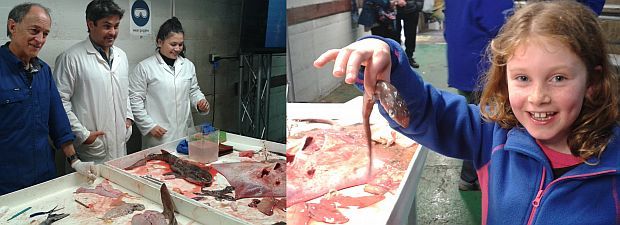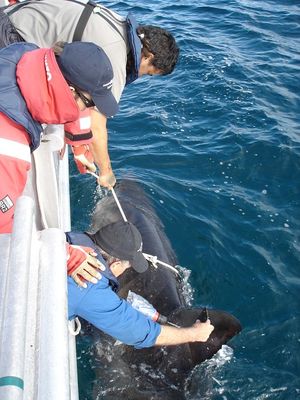
Great white shark experts Malcolm Francis (left) and Ryan Johnson (right) entertained hordes of young shark fans with a shark dissection and talks about sharks at the recent International Science Festival in Dunedin, and this budding scientist was particularly taken with one of five babies found inside a spiny dogfish (images: A. Ballance)
Electronic satellite tags have revolutionised the study of marine creatures such as whales and sharks, allowing scientists to study their movements across long distances.
Great white sharks have been the focus of a joint NIWA-Department of Conservation research programme for the past 10 years. For most of that time Malcolm Francis from NIWA and Clinton Duffy from DoC have focused their tagging efforts at Stewart Island, and what they’re finding is throwing up as many questions as answers.
“In the last couple of years we’ve been putting what we called SPOT tags on the dorsal fin of sharks, and that gives you a really accurate fix every time they come to the surface,” says Malcolm. “And we’re starting to find out now that some of them make direct migrations to the tropics, but we’ve got a couple this last year that have been meandering around a bit and making diversions from their straight line course, and we’ve realise we have no idea what they’re up to.”
 The titi islands near Halfmoon Bay, where the researchers tag their sharks, are a known aggregation site, where sharks congregrate each summer near seal rookeries around the time young fur seals are taking to the water. The tagging research has revealed that great white sharks from New Zealand undertake long migrations up to the tropical Pacific, spending up to 9 months there each year. Sharks have been tracked to Tonga, Fiji, New Caledonia and Australia’s Great Barrier Reef. As well as spending a lot of time at the surface as they travel, they also make frequent deep dives, to depths of 1000 metres or more.
The titi islands near Halfmoon Bay, where the researchers tag their sharks, are a known aggregation site, where sharks congregrate each summer near seal rookeries around the time young fur seals are taking to the water. The tagging research has revealed that great white sharks from New Zealand undertake long migrations up to the tropical Pacific, spending up to 9 months there each year. Sharks have been tracked to Tonga, Fiji, New Caledonia and Australia’s Great Barrier Reef. As well as spending a lot of time at the surface as they travel, they also make frequent deep dives, to depths of 1000 metres or more.
Ex-pat Kiwi Ryan Johnson has been studying white sharks in South Africa since 1998, and he co-founded Oceans Research as well as appearing in many shark documentaries. Over the last two years he has been involved in a large project with Ocearch in which more than 30 great white sharks were fitted with satellite positioning tags on the dorsal fin which send back the shark’s location every time the fin breaks the surface. In the photo (above left) Malcolm Francis is attaching a SPOT tag to the dorsal fin of a great white shark at Stewart Island (image: C. Duffy/DoC).
“We found that the South Africa population of great white sharks shares its time between South Africa and Mozambique,” says Ryan, “Which is massive, as in Mozambique they’re not protected and that has a direct consequence on our [South African] protection for the species.”
“They seem to stay around the seal islands of South Africa during the winter, and then when the warmer temperatures come over the summer that’s when we see these migrations up to Mozambique, Madagascar and a little offshore into the Indian Ocean.”
“It was really exciting to get four or five mature or nearly sexually mature females as those are the ones that are really important …. The big females are pretty much the only ones of the South Africa [white shark] population that explore far offshore,” says Ryan. “We’ve also found that there’s different aggregation sites that we didn’t know about that appear to be related to reproduction.”
Malcolm Francis says understanding what large mature female white sharks do – where they go to mate, feed and give birth - is ‘the missing piece of the puzzle” in New Zealand as well.
Most of the sharks that the researchers see at Stewart Island are sub-adults, with more males seen than females. Larger mature sharks are believed to spend most of their time out in the open ocean, while juvenile sharks are occasionally seen in warmer waters around northern North Island, and in harbours such as the Manukau.
Ryan Johnson and Malcolm Francis were both involved in the Fish and Ships marine science day, run in Dunedin earlier this month as part of the International Science Festival. As well as giving talks about their research they ran a public shark dissection, which attracted many young shark fans keen to learn more about their favourite animals.
You can see where Ryan’s sharks have been travelling on the Ocearch shark tracker web site, and Our Changing World joined Malcolm Francis and Clinton Duffy on a white shark tagging trip to Stewart Island two years ago.


